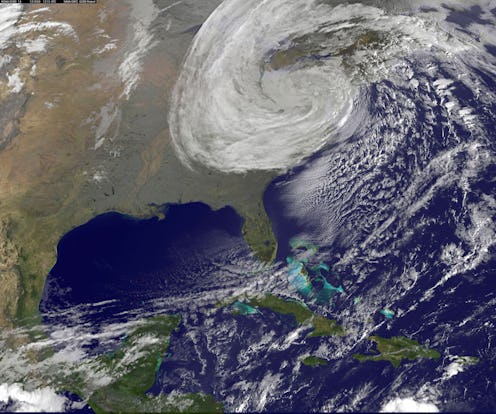News
2017 Could Be An Unusually Active Year For "Major" Hurricanes & Here's Why

As Harvey, once a hurricane, now downgraded to a tropical storm, continues to batter the Gulf Coast of Texas, many people may be looking ahead, wondering what extreme weather events lie on the horizon. So will there be more hurricanes this year? According to the National Oceanic and Atmospheric Administration (NOAA), the federal government's weather division, 2017 is predicted to be an active storm year.
The Atlantic Ocean hurricane season runs from June 1 to Nov. 30. NOAA releases a prediction every spring for how it believes the storm season will stack up. It attempts to predict how many named storms there will be, as well as how many of those will be hurricanes, and how many of those would qualify as "major hurricanes."
NOAA's 2017 predictions suggest there could be 11-17 named storms, meaning storms with winds of 39 mph or higher. Between five and nine of those storms are predicted to potentially become hurricanes; to qualify as a hurricane, storm winds must reach 74 mph or higher. And two to four of those storms could become "major hurricanes," which fall under category 3, 4 or 5 storms. That means their winds much reach 111 mph or higher. This prediction scenario was given a 70 percent likelihood of occurring.
The 2017 season was also given a 45 percent change of being an above-average season. An average season will result in 12 named storms, of which six become hurricanes, and three increase to major hurricanes. This year's above-average status is being attributed to the lack of El Niño winds, which are caused by weak vertical wind shear over the Atlantic and warmer ocean surface temperatures, according to NOAA.
But how many storms have we been through so far this season? Harvey is the eighth named storm so far this year (storms are named in alphabetical order). The seventh storm, Tropical Storm Gert was named on Aug. 13. It's reportedly very early in the season to have that many storms materialize, putting 2017 on track with other highly active storm years. However, prior to Harvey, the Weather Channel described these early-season storms were described as "weak" or "short-lived." There had only been one hurricane prior to Harvey, Hurricane Franklin, and that only maintained hurricane status for 12 hours.
That leaves an estimated three to nine storms that have yet to materialize in 2017, and many of those could be full-blown hurricanes if predictions are accurate. The late summer and early fall months are traditionally the most active part of the hurricane season, so those on the Eastern seaboard or on the Gulf Coast should pay close attention to the weather for the coming weeks.